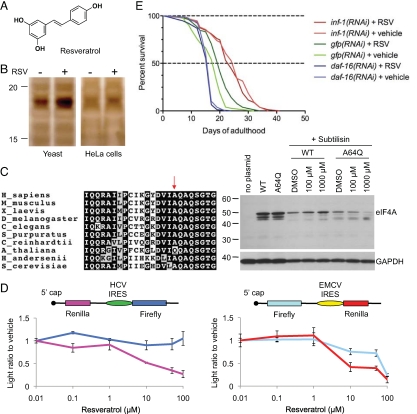Fig. 3.
DARTS identifies a molecular target of resveratrol. (A) Chemical structure of resveratrol. (B) Yeast cell lysates and human HeLa cell lysates were each treated with resveratrol in vitro, followed by thermolysin digestion and silver staining. Protected bands of similar size were detected. (C) Resveratrol protects the wild-type eIF4A, but not the A64Q-substituted eIF4A mutant protein, from proteolysis. (D) Resveratrol inhibits eIF4A-dependent translation in HEK 293 cells as assayed by bicistronic translation reporters. The EMCV IRES requires the eIF4A and eIF4G subunits of eIF4F, whereas the HCV IRES does not (55). (E) eIF4A is required for longevity in resveratrol-treated animals. Resveratrol (50 μM) lengthens the lifespan of wild-type N2 worms fed control (gfp) RNAi (green), but not worms fed eIF4A (inf-1) RNAi (red) or daf-16 RNAi (blue). gfp(RNAi), mVeh = 19 (n = 74), mRSV = 20 (n = 78), ***, P = 0.0006; inf-1(RNAi), mVeh = 26 (n = 76), mRSV = 24 (n = 79), P = 0.4687; daf-16(RNAi), mVeh = 17 (n = 78), mRSV = 17 (n = 76), P = 0.3305. m, mean lifespan (days of adulthood); n, number of animals tested.

